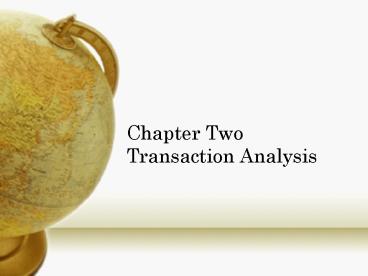Chapter Two Transaction Analysis PowerPoint PPT Presentation
1 / 19
Title: Chapter Two Transaction Analysis
1
Chapter TwoTransaction Analysis
2
Transactions
- Business Transactions are events that have a
financial impact on the business (assign a
amount) and can be measured reliably. - Transactions will impact the Assets, Liabilities,
and Owners Equity of a firm - To analyze, determine how this impacts the
accounting equation (Assets Liabilities
Owners Equity) of a firm
3
Accounts
- Accounts are a summary device that record the
changes that have occurred during a period. - Organizational system for businesses that allow
them to analyze the cumulative effects of
transactions. - Each account shows the effect of all of the
increases and decreases during a period. - Accounts are organized via the basic accounting
equation (Assets Liabilities Owners Equity.)
4
Accounts
- Use a separate account for each particular
- Asset
- Liability
- Stockholders Equity (Owners Equity)
- that is involved in a transaction.
- Each transaction will affect at least two
accounts. This is reflective of the double-entry
system used in accounting, which keeps the
accounting equation in balance. - Know the different types of accounts on pages
55-57. You should also review the lecture
material for Chapter 1.
5
Transaction Analysis
- Remember, the accounting equation helps to
analyze the impact of transactions on financial
position - Assets Liabilities Owners Equity
- There are many examples of the analysis of
business transactions on pages 57-63 in the text.
Make sure to study and understand these examples.
6
Debits and Credits
- Recall that each transaction affects at least two
accounts. - In accounting, accounts can be represented by the
letter T and referred to as T-accounts. - Accountants designate
- Left side of account Debits
- Right side of account Credits
- Total Debits always equal total credits
7
Debits and Credits
Visualization of the T-Account
Adapted from Harrison (2006)
8
Debits and Credits
- Rules for Assets on the left-hand side of the
accounting equation - Assets have a normal debit balance.
- Increases in assets are recorded on the left
(debit) side. - Decreases in assets are recorded on the right
(credit) side. - The balance in the account is calculated as
the beginning balance (what was in the account
at the beginning of the period) increases -
decreases
9
Debits and Credits
- Rules for Liabilities and Owners Equity on the
right-hand side of the accounting equation - Liabilities and Owners Equity (LOE) have a
normal credit balance. - Increases in LOE are recorded on the right
(credit) side. - Decreases in LOE are recorded on the left (debit)
side. - The balance in the account is calculated as
the beginning balance (what was in the account
at the beginning of the period) increases -
decreases
10
Debits and Credits
Adapted from Harrison (2006)
11
Debits and Credits
- Rules of debit and credit for Stockholders
Equity are slightly different, since
stockholders equity is affected by different
types of accounts. - Common Stock Retained Earnings
Dividends - -
-
- - Debit Credit Debit
Credit Debit Credit - Expenses Revenues
- - -
- Debit Credit Debit Credit
12
Debits and Credits
- The following types of accounts (1) have a
normal balance as a debit or credit and (2)
increase with a debit or credit. - Normal Balance
- Assets
Liabilities - Expenses
Revenues - Dividends
Retained Earnings -
Common Stock - (DEBIT)
(CREDIT) - Remember Debit Expenses Assets Dividends (DEAD)
- All other accounts
Credit - Refer to Exhibit 2-7 on page 65 and Exhibit 2-14
on page 73 for charts summarizing these rules.
13
Journal Entries
- In addition to T-accounts, companies record
transactions in a journal. - The journal gives a chronological record of all
of a companys transactions. - Steps
- Specify accounts involved in the transaction,
- Determine whether each account increased or
decreased and apply the rules of debits and
credits, and - Enter the transaction into the journal.
14
Journal Entries
The example below demonstrates proper journal
entry form for the purchase of 500 of supplies
for cash.
15
Posting Journal Entries
- The General Ledger is a group of all T-accounts,
with their balances. - The Posting process transfers information from
the journal to the ledger. - (1) Record items via the journal, via journal
entries. - (2) Post items to the ledger, by recording the
journal entries in the T-accounts.
16
Posting Journal Entries
Adapted from Harrison (2006)
17
Trial Balance
- A trial balance lists all accounts with their
balances in the following order - Assets
- Liabilities
- Stockholders Equity
- Goal to ensure that total debits total
credits. Examine for recording or posting errors.
- Provides that the ledger is in balance, but is
not one of the financial statements.
18
Chart of Accounts
- A chart of accounts is a listing of all of a
companys accounts and their account numbers. - Referenced when posting journal entries or
deciding how to code transactions. - Additional accounts may be added as a company
participates in additional transactions.
19
Questions?
- Any questions or concerns?

